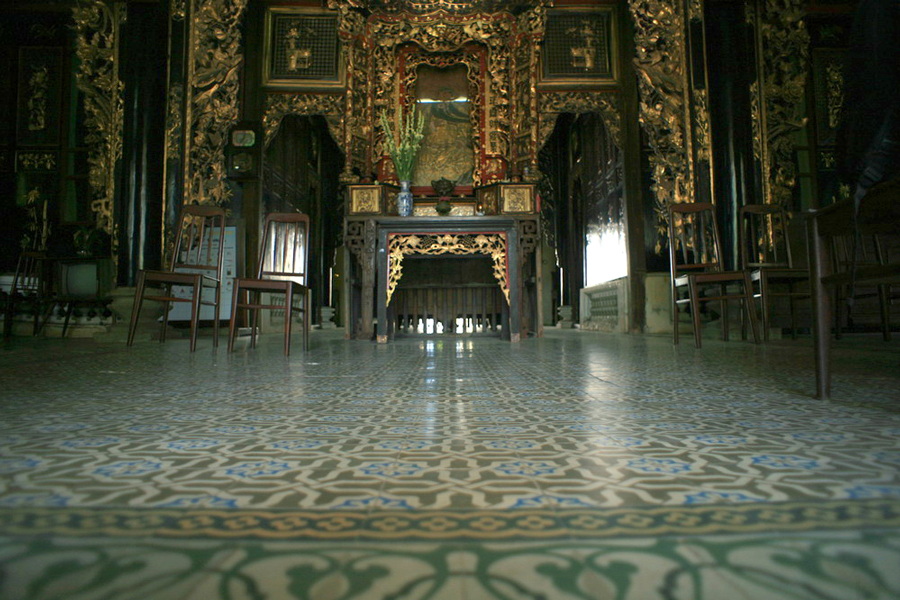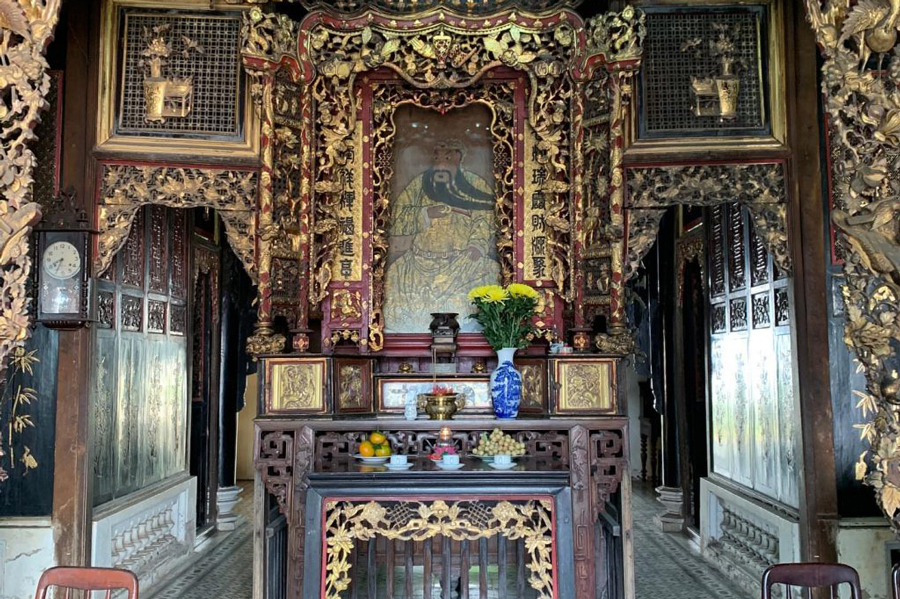Huynh Thuy Le ancient house

Huynh Thuy Le Ancient House, also known as the "Lover's House," stands as a captivating testament to the intertwining threads of history and romance in the town of Sa Dec, Dong Thap Province, Vietnam. Today, the well-preserved ancient house serves as a cultural heritage site, welcoming visitors to explore its intricately designed wooden structure, wander through its historical rooms, and soak in the rich ambiance of a bygone era. The house's significance extends beyond architecture, offering a glimpse into the cultural diversity and historical connections of the Mekong Delta region. Its lush garden and antique furnishings further enhance the immersive experience, making Huynh Thuy Le Ancient House a must-visit destination for those seeking to unravel the layers of Vietnam's captivating past.
Huynh Thuy Le Ancient House traces its history back to its construction in 1895 by Huynh Cam Thuan, a prosperous Chinese-Vietnamese trader. The house stands as a testament to the architectural synthesis prevalent in the region, featuring a distinctive blend of Chinese, Vietnamese, and French influences. Throughout the years, the house gained international recognition due to its association with the love affair between Marguerite Duras, a French writer, and Huynh Thuy Le, the son of its original owner.
The historical significance of the house is deeply intertwined with the narrative of "L'Amant" (The Lover), a semi-autobiographical novel written by Marguerite Duras. This literary work immortalizes the clandestine romance that unfolded between Duras and Huynh Thuy Le during the early 20th century, adding a layer of cultural richness to the historical importance of the house.
Over time, the house has undergone careful preservation and restoration efforts, ensuring that its architectural charm and historical value are maintained. Today, it stands as a cultural heritage site and a popular tourist destination, allowing visitors to step back in time and experience the opulence and lifestyle of the Vietnamese elite during the colonial era. Huynh Thuy Le Ancient House serves not only as a physical embodiment of historical and architectural evolution but also as a living memory of a cross-cultural love story that transcends time and borders.
Huynh Thuy Le Ancient House offers visitors a glimpse into the rich history and cultural heritage of the region.
Architectural Marvel
Marvel at the unique architecture of the house, which reflects a harmonious blend of Chinese, Vietnamese, and French design elements. The wooden structure, intricate carvings, and layout provide insight into the architectural styles prevalent during the late 19th and early 20th centuries.
Historical Rooms

Huynh Thuy Le 's bedroom
Explore the various rooms within the house, each with its own historical significance. From the central hall to family apartments, the layout of the house offers a glimpse into the daily lives of the wealthy Vietnamese elite during the colonial era.
Antique Furniture
Admire the well-preserved antique furniture that adorns the rooms. The furniture reflects the opulence and taste of the time, offering a tangible connection to the lifestyle of the house's original occupants.
Cultural Artifacts
Discover an array of cultural artifacts and personal belongings that provide additional context to the history of the house and its residents. Items such as traditional clothing, household items, and family mementos contribute to the immersive experience.
Garden

The garden is meticulously landscaped with an assortment of lush plants
Take a leisurely stroll through the house's garden, which often features lush greenery, traditional landscaping, and perhaps a pond. The garden provides a tranquil setting and adds to the overall charm of the property.
The curved arch design, reminiscent of Roman architecture, is a prominent feature of the ancient house. The influence of Eastern architecture is evident in sharply carved lines and gilded lacquer depicting images of birds, fruit trees, and various flowers such as bamboo, apricot, chrysanthemum, and peach. The exterior of the house showcases a unique fusion of Western and Chinese architectural styles, with intricate details like ants adorning the outer walls.

Curved arch according to Roman architecture
Inside the house, imported materials such as encaustic tiles and stained glass from France contribute to an elegant ambiance. The central ceiling is adorned with intricate depictions of dragons and bats, showcasing a high level of sophistication. The middle of the house houses an altar dedicated to Quan Cong, embodying a traditional belief symbolizing strength and prosperity in the homeowner's life. The walls, made of precious wood, are painted with gold and intricately carved, reflecting the aristocracy of affluent families from the past.

Western architecture is clearly shown in the facade, ceiling, and window frames
Meticulously carved wooden doors, cabinets, beds, and altars showcase the craftsmanship of the era. Household items such as wine cabinets, bookshelves, kettles, vases, lamps, and gramophones have been well-preserved. The architectural design follows the principles of feng shui with the Long-Lan-Bat-Phung style, deviating from the traditional Long-Lan-Quy-Phung arrangement. The substitution of the bat for the turtle among the four sacred animals symbolizes the cultural exchange process of the Chinese people in the Western river region.

The Quan Cong altar holds cultural and spiritual significance
Despite the challenges of history, the house has remarkably endured, serving as a symbol of centuries-old, unique architecture. Those interested in an immersive experience can book a room in advance, with each room accommodating two people and including breakfast and lunch.

Meticulously carved furniture
The ancient house gained widespread recognition through the novel "L'Amant" by French writer Marguerite Duras, later adapted into the film "The Lover" by director Jean-Jacques Annaud, featuring actors Luong Gia Huy and Jane March. The poignant details in the movie have resonated with many viewers, emphasizing Huynh Thuy Le's role as the main character in the famous novel and highlighting the romantic connection between the French writer and Mr. Huynh Thuy Le.
Poster of the movie The Lover
Opening time: 08:30 - 17:30 all days of the week.
Ticket price: The admission fee is 30,000 VND per person. For those interested in dining at the ancient house, a combined ticket, including meals, is available for 100,000 VND per person. Additionally, if visitors wish to extend their experience and stay overnight, room rates range from 550,000 VND to 1,000,000 VND per night, inclusive of both lunch and breakfast.
The best time to visit Huynh Thuy Le Ancient House is during the dry season, which typically spans from December to April. This period offers more favorable weather conditions and fewer chances of rain, providing a more comfortable and enjoyable experience for visitors.
Specifically, the months of December to February are considered the cool and dry season in southern Vietnam. During this time, temperatures are relatively mild, and the humidity is lower, making it more pleasant for exploring outdoor attractions like the ancient house.
It's advisable to avoid the rainy season, which occurs from May to November, as the Mekong Delta region experiences heavy rainfall and the potential for flooding. Visiting during the dry season increases the likelihood of having clear skies and better conditions for travel and exploration.
Ultimately, planning your visit to Huynh Thuy Le Ancient House during the dry months ensures a more pleasant and comfortable experience, allowing you to fully appreciate the historical and cultural richness of this captivating destination.
To reach Huynh Thuy Le Ancient House, you have the option of purchasing a bus ticket to Dong Thap from either Mien Dong Bus Station or An Suong Bus Station if you're departing from Ho Chi Minh City. The journey from Ho Chi Minh City to Dong Thap takes approximately 3 hours. Once the bus arrives at Sa Dec Bus Station, you can then take a taxi or motorcycle taxi to your final destination.
Alternatively, many individuals opt for personal transportation such as motorcycles or cars. If departing from Ho Chi Minh City, follow these directions: Head towards Sa Dec city on National Highway 1A (Note: avoid entering the Ho Chi Minh City - Trung Luong highway). The route is around 140 km long, approximately 5 km longer than the highway route. After crossing Bac My Thuan bridge, continue along Highway 80 for about 5 km more to reach the ancient house.